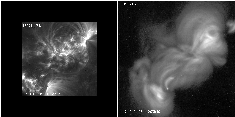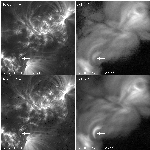
The first target was an active region complex comprising two active regions (AR8299 and AR8297) in the northern hemisphere. This complex was relatively quiet throughout the observations (exhibiting only 1 small C flare during the two days of the campaign. However, there were a number of interesting loop brightenings, one of which is shown below. The first image shows the early part of a small loop brightening which began with what appears to be a small bright footpoint in the SXT image. The nearest TRACE image is approximately 1 minute prior to the formation of the bright knot at the base of the loop.
Click the figure below.

This loop brightening and bright point in the SXT images occurs on what appears to be a large-scale separatrix surface in the SE quadrant of 8299 . There is a sequence of 110 vector magnetograms from the Mees IVM of this region spanning the same time period (as well as MCCD scans and a Stokes Polarimeter vector magnetogram. The data from SXT, TRACE and Mees will make a nice dataset for those interested in the role of topology and reconnection in such brightenings.
Subsequent development of this small loop saw it brighten in the SXT and TRACE 171 images with an intersting loop appearing in the TRACE sequence.
